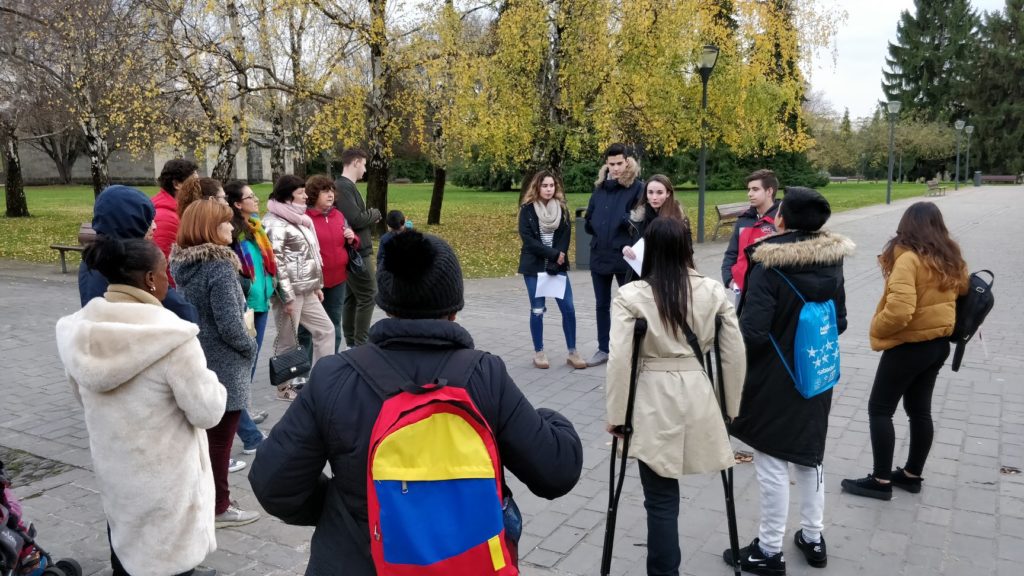Pamplona’s Sagrado Corazón School worked with the CHANGE project, and some student ambassadors want to share their experience:
One of the subjects the high school students of Pamplona study in their penultimate year is the historical and artistic heritage of the Navarra autonomous community and of their city, as part of Art History. We were asked to prepare an assignment about how a group of visitors would be taught about Pamplona’s cultural and artistic riches. It was at this point that a worker from the Spanish Commission for Aid to Refugees [CEAR] told us about the situation of asylum seekers in our city. We learned the legal, personal, economic and psychological journey that an individual must face when fleeing their country of origin. We were told that Pamplona hosted people from different countries waiting for the processing of their asylum applications. While waiting, they attend workshops to facilitate their social integration in the city.
We proposed to CEAR that our Art History assignment could be useful to show the asylum applicants Pamplona. To that end, we started showing the city to mixed groups. The language barrier was the main challenge, but we managed to overcome it with goodwill on all sides. Everyone learned a great deal: half the group learned the “treasures” and “secrets” of their new adopted city of Pamplona from the young students, and the other half was able to take a closer look at the reality faced by refugees today, a reality that hits far closer to home than expected. It was a great experience that we’d like to keep up!
Arte e Historia de nuestra ciudad para tod@s
En el Colegio Sagrado Corazón de Pamplona han trabajado con el proyecto CHANGE y un grupo de estudiantes embajadores/as han querido compartir esta experiencia:
En la asignatura de Historia del Arte que cursa el alumnado del 2º de Bachillerato estudiamos, entre otros muchos temas, el patrimonio histórico-artístico de nuestra comunidad Navarra y de la ciudad en la que vivimos, Pamplona.
Tuvimos que preparar un trabajo sobre cómo enseñaríamos la riqueza cultural y artística de Pamplona a un grupo de visitantes. Para ello, diseñamos un recorrido lógico y pensamos en qué puntos nos pararíamos para dar las oportunas explicaciones.
Fue entonces cuando vino al colegio una trabajadora de CEAR (Comisión Española de Ayuda al Refugiado) para explicarnos la situación de las personas solicitantes de asilo en nuestra ciudad. Con ella aprendimos el itinerario legal, personal, económico, psicológico… que sufre una persona que se ve obligada a huir de su país. Y nos dijo que en Pamplona había personas de diferentes países que se encontraban esperando a que se tramitase su solicitud asilo. Durante esta espera iban recibiendo unos talleres para facilitar su integración en la ciudad.
Propusimos a CEAR que nuestro trabajo de Historia del Arte sirviera para enseñar Pamplona a grupos de solicitantes de asilo. Por ello comenzamos con las visitas en las que fuimos enseñando la ciudad a grupos muy heterogéneos de personas. La principal dificultad fue el idioma, pero con buena voluntad no fue un obstáculo.
Todos/as aprendimos mucho: unos que jóvenes de Pamplona les mostraban los “tesoros” y “secretos” de su nueva ciudad; y otros pudimos conocer de cerca la realidad de refugiados que está mucho más cerca de lo que pensábamos. Fue una gran experiencia que queremos seguir repitiendo.
Gure hiriaren artea eta historia guztiontzat
Iruñeko Jesusen Bihotza Ikastetxean CHANGE proiektuarekin lan egin dute eta ikasle enbaxadore talde batek bere esperientzia partekatzen digu:
Batxilergoko 2. urteko ikasleek ikasten duten Artearen Historia irakasgaian, beste gai askoren artean, gure Nafarroako erkidegoko eta bizi garen hiriko (Iruñea) ondare historiko-artistikoa ikasi genuen.
Iruñearen aberastasun kultural eta artistikoa bisitari-talde bati nola irakatsiko genion jakiteko lan bat prestatu behar izan genuen. Horretarako, ibilbide logiko bat diseinatu genuen eta azalpenak emateko zein puntutan geldituko ginen pentsatu genuen.
Orduan, errefuxiatuei Laguntzeko Espainiako Batzordeko (CEAR) langile bat etorri zen eskolara, gure hiriko asilo-eskatzaileen egoera azaltzeko. Bere herrialdetik ihes egin behar duen pertsona batek jasaten duen ibilbide legal, pertsonal, ekonomiko eta psikologikoa ikasi genuen. Eta esan zigun Iruñean hainbat herrialdetako pertsonak zeudela asilo-eskaera tramitatzeko zain. Itxaronaldi horretan tailer batzuk jasotzen ari ziren, hirian integratzea errazteko.
CEARi proposatu genion Artearen Historiako gure lanak asilo-eskatzaileen taldeei Iruñea irakasteko balio zezala. Horregatik, bisitekin hasi ginen, eta hiria oso talde heterogeneoei erakutsi genien. Zailtasun nagusia hizkuntza izan zen, baina borondate onez ez zen oztopo izan.
Denok ikasi genuen asko: Iruñeko gazte batzuek beren hiri berriaren “altxorrak” eta “sekretuak” erakusten zizkieten; eta beste batzuek uste baino hurbilago dauden errefuxiatuen errealitatea gertutik ezagutu ahal izan genuen. Esperientzia handia izan zen, eta errepikatzen jarraitu nahi dugu.

